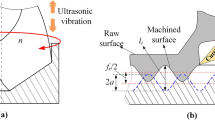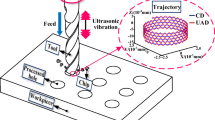Abstract
Improving the surface quality of additive manufactured parts like poly lactic acid (+) is an important study that is currently being carried out by researchers. To reach the high-quality, different conventional and nonconventional methods are applied. In this study, the capability of ultrasonic vibration in drilling of an additive manufactured poly lactic acid (+)was examined. The process was implemented in two methods: conventional and vibratory drilling. Then, thrust force and chip type were analyzed, and the effect of them on surface roughness, delamination, circularity, and cylindricality have been investigated. As a result, it was indicated that lower thrust force and broken chips, which were generated in ultrasonic drilling, caused the surface quality parameters to be improved compared to the conventional method.










Similar content being viewed by others
Availability of data and materials
It is confirmed that the data and materials can be available after publication on the basis of springer nature rights and access.
References
Wang P, Wang D (2020) Evaluation of different tool geometries in the finite element simulation of ultrasonic-assisted drilling of Ti6A14V. J Braz Soc Mech Sci Eng 42(4):1–14
Yarar E, Karabay S (2020) Investigation of the effects of ultrasonic assisted drilling on tool wear and optimization of drilling parameters. CIRP J Manuf Sci Technol 31:265–280
Moghaddas MA, Graff KF (2020) On the effect of load on vibration amplitude in ultrasonic-assisted drilling. Int J Adv Manuf Technol 106(7-8):3081–3094
Lotfi M, Amini S, Akbari J (2020) Surface integrity and microstructure changes in 3D elliptical ultrasonic assisted turning of Ti–6Al–4V: FEM and experimental examination. Tribol Int 151:106492
Wang J, Zhang J, Feng P, Guo P (2018) Experimental and theoretical investigation on critical cutting force in rotary ultrasonic drilling of brittle materials and composites. Int J Mech Sci 135:555–564
Kumar S, Dvivedi A (2019) On machining of hard and brittle materials using rotary tool micro-ultrasonic drilling process. Mater Manuf Process 34(7):736–748
Feng Q, Cong WL, Pei ZJ, Ren CZ (2012) Rotary ultrasonic machining of carbon fiber-reinforced polymer: feasibility study. Mach Sci Technol 16(3):380–398
Debnath K, Singh I, Dvivedi A (2015) Rotary mode ultrasonic drilling of glass fiber-reinforced epoxy laminates. J Compos Mater 49(8):949–963
Tabatabaeian A, Baraheni M, Amini S, Ghasemi AR (2019) Environmental, mechanical and materialistic effects on delamination damage of glass fiber composites: analysis and optimization. J Compos Mater 53(26-27):3671–3680
Wei L, Wang D (2020) Effect of ultrasound-assisted vibration on Ti-6Al-4V/Al2024-T351 laminated material processing with geometric tools. Int J Adv Manuf Technol 106(1-2):219–232
Wu CQ, Gao GL, Li HN, Luo H (2019) Effects of machining conditions on the hole wall delamination in both conventional and ultrasonic-assisted CFRP drilling. Int J Adv Manuf Technol 104(5-8):2301–2315
Castro-Aguirre E, Iniguez-Franco F, Samsudin H, Fang X, Auras R (2016) Poly (lactic acid)—Mass production, processing, industrial applications, and end of life. Adv Drug Deliv Rev 107:333–366
Alexander I, Vladimir G, Petr P, Mihail K, Yuriy I, Andrey V (2016) Machining of thin-walled parts produced by additive manufacturing technologies. Proc CIRP 41:1023–1026
Park E, Kim DM, Park HW, Park YB, Kim N (2020) Evaluation of tool life in the dry machining of inconel 718 parts from additive manufacturing (AM). Int J Precis Eng Manuf 21(1):57–65
Bordin A, Bruschi S, Ghiotti A, Bariani PF (2015) Analysis of tool wear in cryogenic machining of additive manufactured Ti6Al4V alloy. Wear 328:89–99
Ming W, Dang J, An Q, Chen M (2020) Chip formation and hole quality in dry drilling additive manufactured Ti6Al4V. Mater Manuf Process 35(1):43–51
Rysava Z, Bruschi S, Carmignato S, Medeossi F, Savio E, Zanini F (2016) Micro-drilling and threading of the Ti6Al4 v titanium alloy produced through additive manufacturing. Proc CIRP 46:583–586
Dang J, Cai X, Yu D, An Q, Ming W, Chen M (2020) Effect of material microstructure on tool wear behavior during machining additively manufactured Ti6Al4V. Arch Civi Mech Eng 20(1):4
Khaliq W, Zhang C, Jamil M, & Khan AM (2020) Tool wear, surface quality, and residual stresses analysis of micro-machined additive manufactured Ti–6Al–4V under dry and MQL conditions.Tribol Int 151:106408
Altintas Y (2012) Manufacturing automation: metal cutting mechanics, machine tool vibrations, and CNC design. Cambridge university press, Cambridge
Lotfi M, Amini S (2019) Effect of longitudinally intermittent movement of cutting tool in drilling of AISI 1045 steel: a three-dimensional numerical simulation. Proc Inst Mech Eng C J Mech Eng Sci 233(12):4081–4090
Dahnel AN, Ascroft H, Barnes S (2016) The effect of varying cutting speeds on tool wear during conventional and ultrasonic assisted drilling (UAD) of carbon fibre composite (CFC) and titanium alloy stacks. Proc Cirp 46(1):420–423
Lotfi M, Amini S (2017) Experimental and numerical study of ultrasonically-assisted drilling. Ultrasonics 75:185–193
Seah KHW, Rahman M, Li XP, Zhang XD (1996) A three-dimensional model of clip flow, chip curl and chip breaking for oblique cutting. Int J Mach Tools Manuf 36(12):1385–1400
Kadivar MA, Akbari J, Yousefi R, Rahi A, Nick MG (2014) Investigating the effects of vibration method on ultrasonic-assisted drilling of Al/SiCp metal matrix composites. Robot Comput Integr Manuf 30(3):344–350
Baraheni M, Amini S (2019) Comprehensive optimization of process parameters in rotary ultrasonic drilling of CFRP aimed at minimizing delamination. Int J Lightweight Mater Manuf 2(4):379–387
Geng D, Liu Y, Shao Z, Lu Z, Cai J, Li X, Jiang X, Zhang D (2019) Delamination formation, evaluation and suppression during drilling of composite laminates: a review. Compos Struct 216:168–186
Baraheni M, Amini S (2018) Feasibility study of delamination in rotary ultrasonic-assisted drilling of glass fiber reinforced plastics. J Reinf Plast Compos 37(1):3–12
Wei L, Wang D (2019) Comparative study on drilling effect between conventional drilling and ultrasonic-assisted drilling of Ti-6Al-4V/Al2024-T351 laminated material. Int J Adv Manuf Technol 103(1-4):141–152
Shao Z, Jiang X, Li Z, Geng D, Li S, Zhang D (2019) Feasibility study on ultrasonic-assisted drilling of CFRP/Ti stacks by single-shot under dry condition. Int J Adv Manuf Technol 105((1-4)):1259–1273
Chu NH, Nguyen VD, Ngo QH (2020) Machinability enhancements of ultrasonic-assisted deep drilling of aluminum alloys. Mach Sci Technol 24((1)):112–135
Liu D, Cong WL, Pei ZJ, Tang Y (2012) A cutting force model for rotary ultrasonic machining of brittle materials. Int J Mach Tools Manuf 52(1):77–84
Moghaddas MA, Yi AY, Graff KF (2019) Temperature measurement in the ultrasonic-assisted drilling process. Int J Adv Manuf Technol 103((1-4)):187–199
Author information
Authors and Affiliations
Contributions
Mohammad Baraheni had 60% contribution in conducting the research and analyzing the results; Mohammad Reza Shabgard had 25% contribution in supervising the research; Saeid Amini had 15% contribution in providing facilities.
Corresponding author
Ethics declarations
Ethics approval
It is approved that the paper is original and has been written based on the authors’ own findings. All the figures and tables are original, and every expression from other published works was acknowledged and referenced.
Consent to participate
It is confirmed that all the authors are aware and satisfied with the authorship order and correspondence of the paper
Consent for publication
All the authors are satisfied that the last revised version of the paper is published without any change
Competing interests
The authors declare no competing interests.
Additional information
Publisher’s note
Springer Nature remains neutral with regard to jurisdictional claims in published maps and institutional affiliations.
Rights and permissions
About this article
Cite this article
Baraheni, M., Shabgard, M.R. & Amini, S. Evaluating the hole quality produced by vibratory drilling: additive manufactured PLA+. Int J Adv Manuf Technol 117, 785–794 (2021). https://doi.org/10.1007/s00170-021-07750-8
Received:
Accepted:
Published:
Issue Date:
DOI: https://doi.org/10.1007/s00170-021-07750-8




